
Facebook had 50 million active business pages as of December 2015, up from 40 million eight months earlier. Assuming sustained growth through today, there are upwards of 70 million active Facebook business pages in April 2017. It makes good business sense for small and medium-sized businesses to follow this trend when they glance at the numbers.
Facebook boasts an astounding 1.23 billion daily active users, and 1.86 billion monthly active users. Facebook is a theoretical must-have for all businesses due to the sheer number of potential customers that can be reached. Unfortunately great odds don’t necessarily translate to success.
Social media is an important part of all marketing strategies. Facebook marketing has taken on a life of its own in the last couple years. But the resources marketing departments are allocating to the world’s largest social network are better spent elsewhere.
Numbers perspective
Facebook’s 1.86 million active monthly users are nothing to sneeze at. That is a humongous potential profit pie for companies to explore. A more comprehensive look at the numbers tells a different story.
A vast majority of Facebook users, more than 85%, are located outside of the United States and Canada. China, the most populous country and fastest growing economy in the world after surpassing India last year, banned Facebook in 2009. Some Chinese people still access Facebook via VPN, but there’s no way of estimating how many.
Facebook’s first quarterly earnings report after its IPO in 2012 indicated that at least 8.7% of users were fake, meaning they were duplicates, “misclassified,” or “undesirable.” The company’s 2015 annual report put the number at about 7% fake accounts. Averaging those numbers out, upwards of 150 million Facebook profiles are fake.
Despite all the aforementioned, there are still millions of Facebook users who may be interested in your product or service. Now its just a matter of reaching them.
Facebook algorithm changes
Facebook Ads launched in November of 2007, with one of the features being that businesses could “build pages on Facebook to connect with their audiences.” This was only 28 months after the company acquired the domain Facebook.com for $200,000, so business (fan) pages have been around for most of the social network’s existence. The way these pages operate has changed dramatically since then.
When business and fan pages started, administrators enjoyed very high organic reach with its followers. Facebook was the go-to platform for major brands and small businesses to build large followings and post unlimited promotional and customer relations content 24 hours a day, 7 days a week. Facebook’s initial public offering (IPO) in May of 2012 immediately changed how the platform worked. The company now had shareholders to satisfy. Its entire philosophy changed almost overnight, and made many influential people angry in the process.
George Takei, the long-time Star Trek actor, noticed the change in June that year and posted a not-so-subtle note to his two million followers about it.
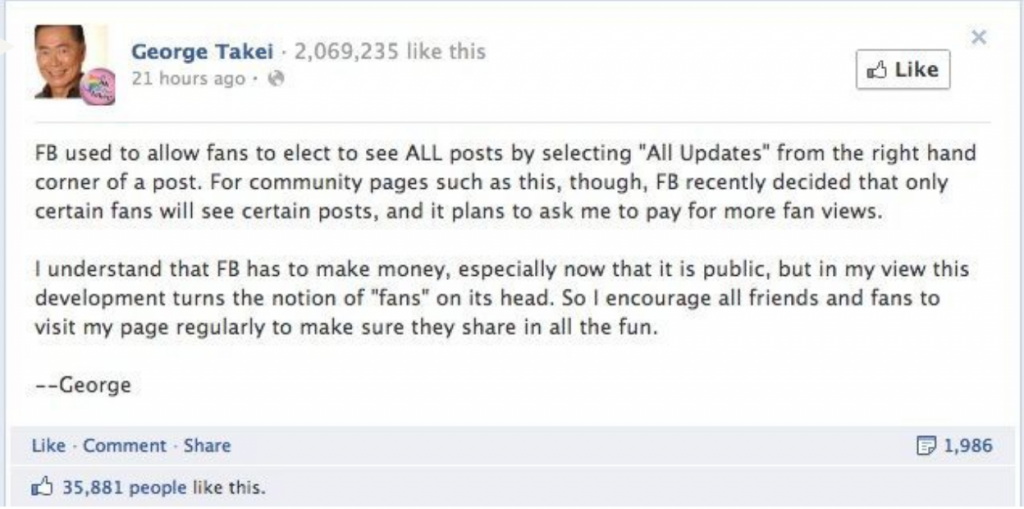 A Facebook employee responded to Takei, saying the company had not changed anything about the way posts were disseminated. Instead, according to the employee, Facebook made the user experience better by making the content they see more relevant. But Takei was not satisfied with the explanation, as he posted a very similar note several months later.
A Facebook employee responded to Takei, saying the company had not changed anything about the way posts were disseminated. Instead, according to the employee, Facebook made the user experience better by making the content they see more relevant. But Takei was not satisfied with the explanation, as he posted a very similar note several months later.
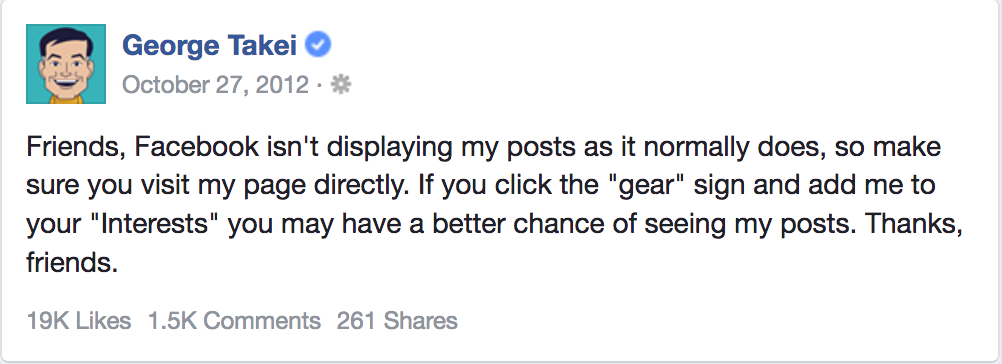 Billionaire Mark Cuban, who owns the NBA’s Dallas Mavericks, talked about the changes to Facebook business pages in November of 2012. The team posted a promo for an upcoming game on Facebook assuming it would reach a large percentage of its 2.3 million followers at the time. The post only reached 27,000 of the Mavericks’ followers organically (or about 1.1%). Cuban tweeted his assessment of Facebook, along with a screenshot of Facebook demanding $3,000 for the Mavericks to reach about half of their followers (NOTE: the tweet has since been deleted).
Billionaire Mark Cuban, who owns the NBA’s Dallas Mavericks, talked about the changes to Facebook business pages in November of 2012. The team posted a promo for an upcoming game on Facebook assuming it would reach a large percentage of its 2.3 million followers at the time. The post only reached 27,000 of the Mavericks’ followers organically (or about 1.1%). Cuban tweeted his assessment of Facebook, along with a screenshot of Facebook demanding $3,000 for the Mavericks to reach about half of their followers (NOTE: the tweet has since been deleted).
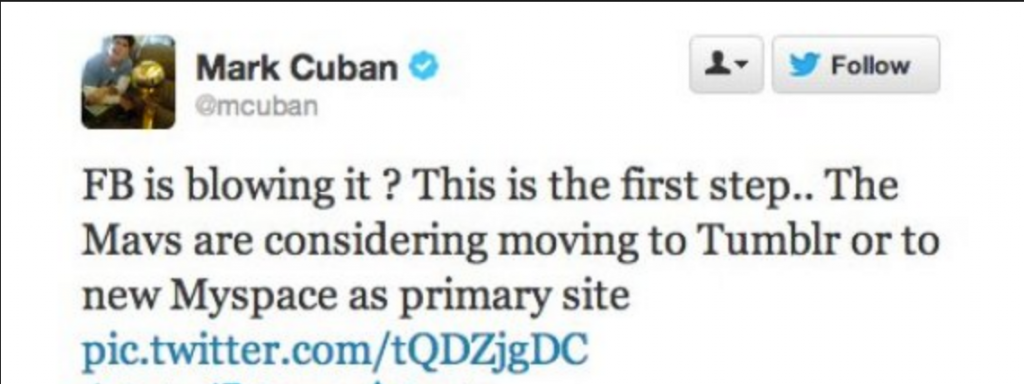
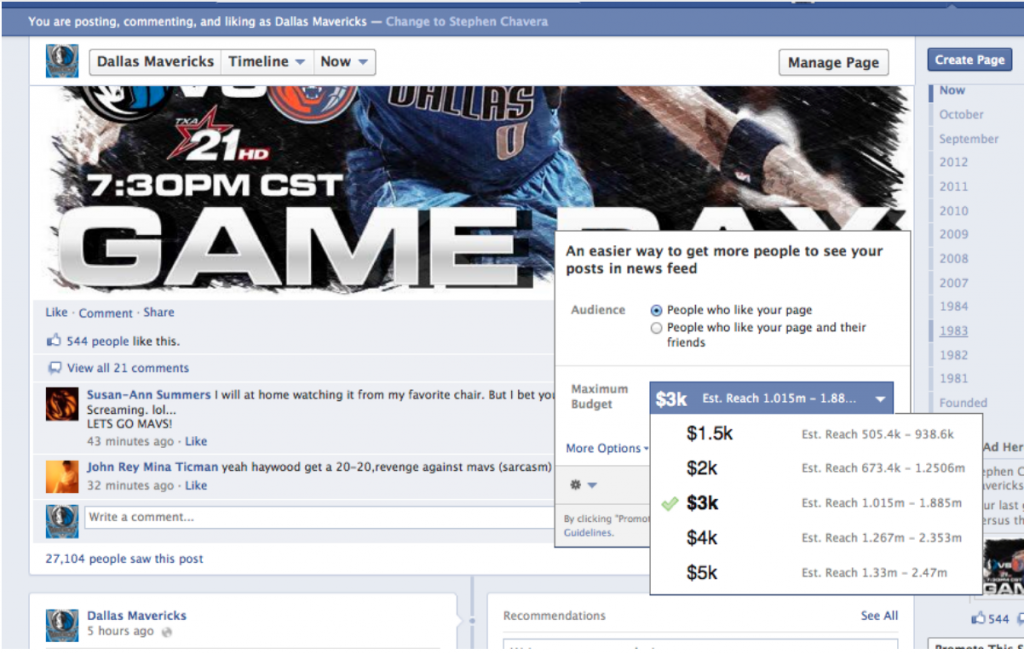
A few days later Cuban expanded on his tweet in a Huffington Post article. He was not recommending companies leave Facebook, but that they de-emphasize it in favor of Instagram, Twitter, Tumblr and other social networks.
Post-IPO Facebook changed its news feed algorithm to reduce average organic reach by business pages to 16% of its followers, according to a 2014 white paper by Social@Ogilvy. Further, the more followers you had, the less your organic reach. By October of 2013, average organic reach dropped to 12%. Pages with more than 500,000 followers, however, dropped to an average of 4% organic reach. Four months later, in February 2014, average organic reach for all business pages dropped to 6.2%, and to 2.1% for pages with more than 500,000 followers. Facebook announced more changes to its algorithm in June of last year, leading to even lower organic reach.
There are things you can do on Facebook to increase organic reach of followers. As Mr. Takei suggested above, tell followers to prioritize your posts. Today this is done a little differently than he described in his 2012 post.
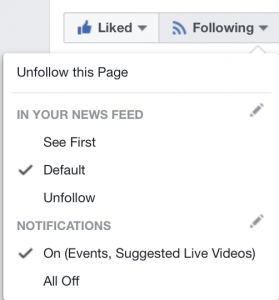
Facebook Live broadcasts and videos published on the native Facebook video platform (versus externally-linked videos) tend to get more interactions. The algorithm also recognizes quality content, which uses factor such as word frequency, choice and count. Its just another reason why company blogs with high-quality content are such valuable assets.
The only way businesses truly reap the benefits of Facebook is by paying for it. We recently tested out paid advertising on Facebook for a clients’ business page that sells encrypted email service. We authorized Facebook to take $50 from the clients’ credit card to “boost” a post about online privacy in the wake of Senate Joint Resolution 34 being signed into law earlier this month. The campaign was supposed to run for four days. Facebook ultimately took $30 from the client’s credit card and ended the campaign after three days for whatever reason. The client just joined Facebook that week, so only had five followers before the boosted post, which ultimately reached 1,266 news feeds (60 organically), got 110 total engagements, and only ONE click on the actual link.
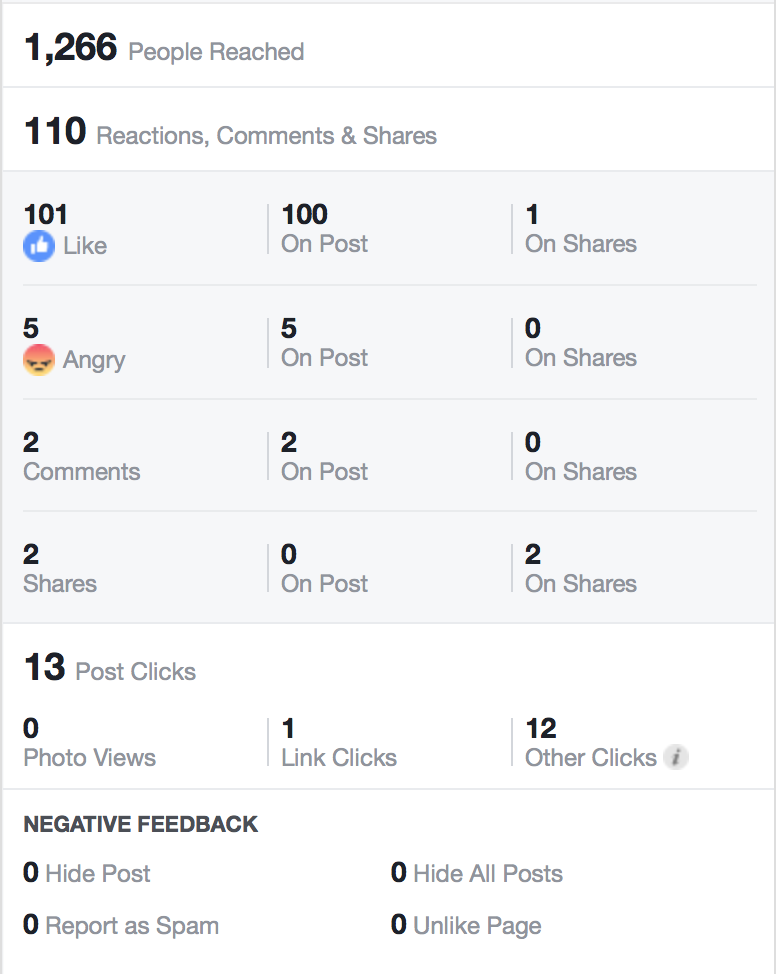
At that rate, you’re paying about $30 per click-through to your actual website, even when the audience is targeted by demographics and user habits. A higher budget will help, but that money is better spent investing in your own website, particularly on publishing daily, high-quality blog content and growing your email list.
Social vs. professional network
When you log into Facebook, you expect to see embarrassing breakups, what people are having for breakfast and the new sweater somebody bought their dog. Its nothing short of cringe-worthy when the same type of stuff shows up on LinkedIn. Jerome Knyszewski was the first to publish an article on LinkedIn about this, and there have since been several iterations by others.
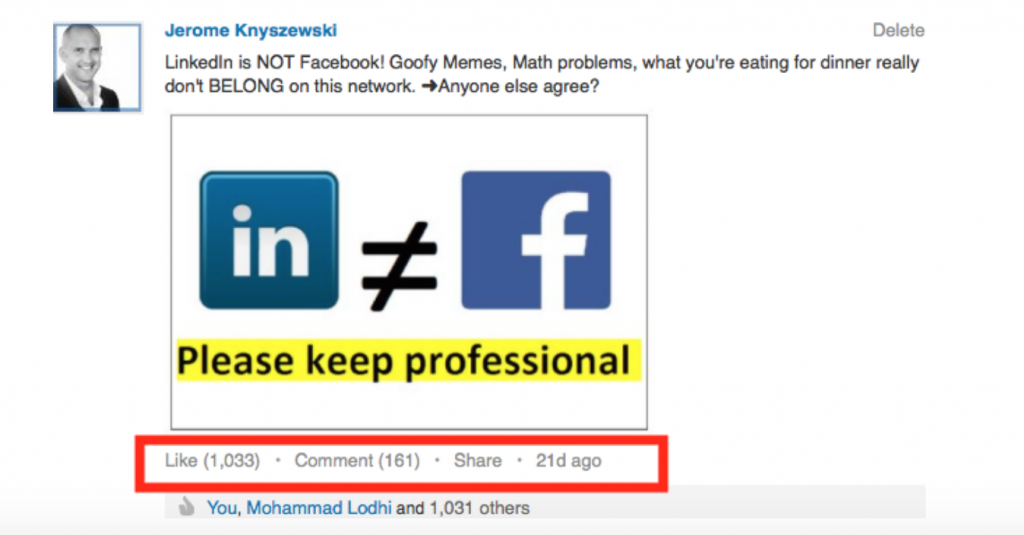
Facebook specifically states on its homepage that it is a social network that helps you “connect with friends.” LinkedIn specifically states on its company page that it exists to “[connect] the world’s professionals to make them more productive and successful.”
LinkedIn has a fraction of the active users of Facebook, with about 467 million registered users in 200 countries. The U.S. has the highest number of registered LinkedIn users by far with over 133 million. India comes in a distant second with 39 million. LinkedIn is the obvious priority for U.S.-based B2B companies’ social media investments. B2C companies have more opportunities to leverage Facebook in their favors, while LinkedIn provides a means of connecting with others in their respective industries.
The 2016 Hubspot “State of Inbound” marketing report proved two things: old school still works and investing in your own website instead of social media is smart. Whether sales teams increased or decreased in numbers, companies identified phone and email communications as the most successful channels for their salespeople to reach prospects.
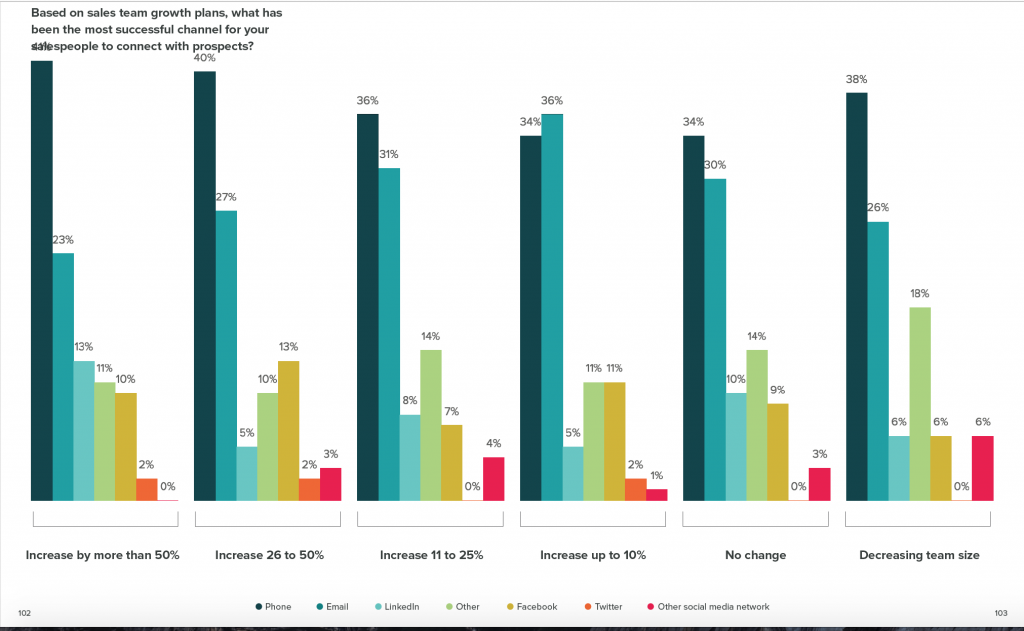
Phone communications typically originated from email communications via prospects and leads contacting or subscribing to company blogs or websites. The report suggested that companies stop cold-calling and contact warm leads who responded to content on their websites. Growing your email list is thus more important than growing your number of Facebook followers.
Though there was no significant difference between Facebook and LinkedIn success rates for salespeople, the tiebreaker is organic reach. Last week on LinkedIn, I published an article on my personal account with only 225 connections. But as of publishing 110 people saw it, or about 49% of my followers. Further, big brands are using Twitter far more than they do all other social networks, according to Forrester Research.
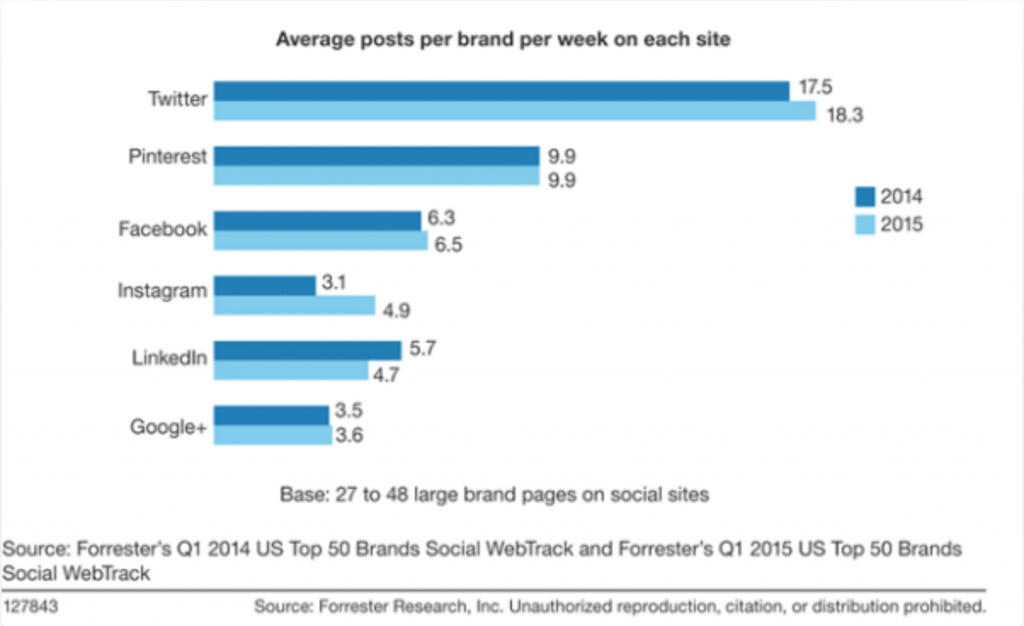
Bottom line
If you’ve had a Facebook business page for years, and have over 1,000 followers, its unwise to just ditch it. Its best to learn more about your followers with Facebook Insights and try to figure out from the data the best approach to increase organic reach. Unless you’re willing to spend more money, time and effort to reach followers, its best to prioritize your own web properties.
A Facebook business page is good to have even if you don’t use it a lot. People may search for your company on the platform and find contact information. Even the largest, most successful brands in the world aren’t heavily active on Facebook because of the time and investment it takes to get even minimal returns. Coca Cola (102 million followers) and Starbucks (36 million followers) sometimes go weeks without posting anything, but they’re still on top of their respective industries. Both companies have very active blogs with great content.
All companies – small, medium and large; B2B and B2C – should have a Facebook page for SEO purposes and to have another means of communication with customers and leads. Investing a lot of time, money and effort into it takes away from investing in your own websites that you have 100% control over. Use Facebook to supplement your blogs and websites, not the other way around.
RELATED: How much should you pay for content marketing?
Are you ready to reap the benefits of publishing high-quality content on your company blog? Do you need to start a new blog from scratch? Read about Content Coup, check out pricing and contact us today. Cut out the middle man and join the revolution!